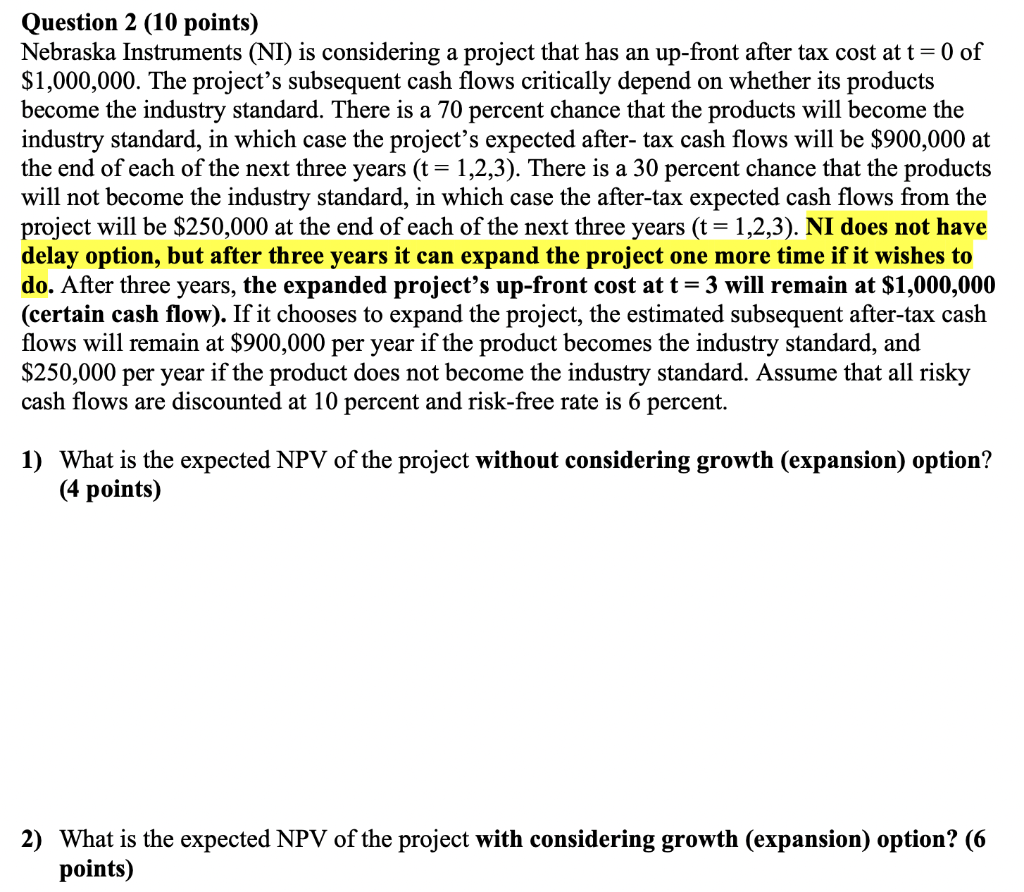
a Question 2 (10 points) Nebraska Instruments (NI) is considering a project that has an up-front after tax cost at t= 0 of $1,000,000. The project's subsequent cash flows critically depend on whether its products become the industry standard. There is a 70 percent chance that the products will become the industry standard, in which case the project's expected after-tax cash flows will be $900,000 at the end of each of the next three years (t = 1,2,3). There is a 30 percent chance that the products will not become the industry standard, in which case the after-tax expected cash flows from the project will be $250,000 at the end of each of the next three years (t = 1,2,3). NI does not have delay option, but after three years it can expand the project one more time if it wishes to do. After three years, the expanded project's up-front cost at t = 3 will remain at $1,000,000 (certain cash flow). If it chooses to expand the project, the estimated subsequent after-tax cash flows will remain at $900,000 per year if the product becomes the industry standard, and $250,000 per year if the product does not become the industry standard. Assume that all risky cash flows are discounted at 10 percent and risk-free rate is 6 percent. 1) What is the ex (4 points) NPV of the project without considering growth (expansion) option? 2) What is the expected NPV of the project with considering growth (expansion) option? (6 points) a Question 2 (10 points) Nebraska Instruments (NI) is considering a project that has an up-front after tax cost at t= 0 of $1,000,000. The project's subsequent cash flows critically depend on whether its products become the industry standard. There is a 70 percent chance that the products will become the industry standard, in which case the project's expected after-tax cash flows will be $900,000 at the end of each of the next three years (t = 1,2,3). There is a 30 percent chance that the products will not become the industry standard, in which case the after-tax expected cash flows from the project will be $250,000 at the end of each of the next three years (t = 1,2,3). NI does not have delay option, but after three years it can expand the project one more time if it wishes to do. After three years, the expanded project's up-front cost at t = 3 will remain at $1,000,000 (certain cash flow). If it chooses to expand the project, the estimated subsequent after-tax cash flows will remain at $900,000 per year if the product becomes the industry standard, and $250,000 per year if the product does not become the industry standard. Assume that all risky cash flows are discounted at 10 percent and risk-free rate is 6 percent. 1) What is the ex (4 points) NPV of the project without considering growth (expansion) option? 2) What is the expected NPV of the project with considering growth (expansion) option? (6 points)







